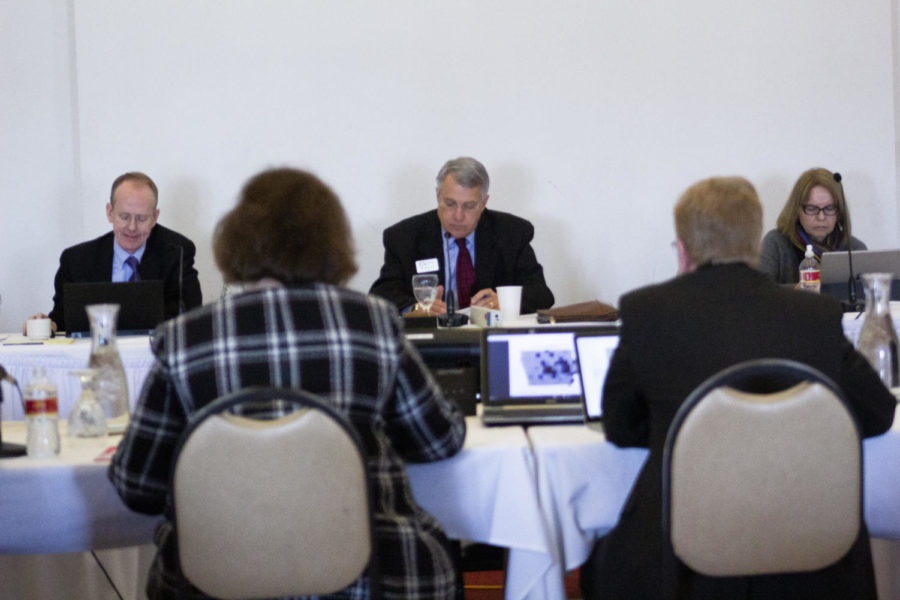Board of Regents approves first reading of 3.9 percent tuition hike
Kennedy DeRaedt/Iowa State Daily
Regent Milt Dakovich (middle) starts the Board of Regents meeting. The regents hosted a meeting Feb. 27, 2019, in the Reiman Ballroom at the Alumni Center.
May 1, 2019
Tuition hikes for Iowa State and the University of Iowa passed through first reading unanimously at the Board of Regents special meeting Wednesday.
The approved tuition increases would raise Iowa State resident undergraduate tuition by $302 or 3.9 percent. For non-resident undergraduates this number is $1,086, or a 4.9 percent increase.
Iowa State resident and nonresident graduate students will see an increase in tuition of 4.9 percent if passed again in the board’s June meeting. This increase constitutes a $456 tuition increase for resident graduate students and $1,156 for non-resident graduate students.
“No one is thrilled to be having this discussion once again on the tuition increase proposals,” said Austin Graber, Iowa State student body president at the telophonic meeting. “These discussions and these meetings are happening too often.”
Graber said he reviewed the statement provided by former student body president Julian Neely to the Regents on tuition one year ago, and that the narrative between those years had not changed. Graber pointed to this trend of increasing tuition as problematic.
The board originally proposed a $7 million increase to Iowa State, contingent on the Republican-led state Legislature fully funding the Governor and Board of Regents request of $18 million. This request was turned down and instead replaced with a plan to increase Regent appropriations by $12 million.
“Our $7 million, cut to $4 million is disheartening,” Graber said. “We have to find solutions to our hard working students and my fellow classmates. Clearly higher education is not a top priority in the state based on the current proposals.”
University of Iowa student body president Noel Mills also criticized the Iowa Legislature and end proposal from the Regents to raise University of Iowa resident undergraduate tuition by $303, or 3.9 percent.
“These increases make up to be around 30 hours of work, eight appointments of donating plasma or skipping 60 meals,” Mills said. “These are very real consequences for my peers and for me.”
Between the three Regent universities, Iowa State would see the largest increases in tuition under the current proposal, especially when it comes to non-resident and graduate tuition. While Iowa State proposed a 4.9 percent increase for all graduate students and non-resident undergraduate students, the University of Iowa would increase tuition for these groups a smaller amount than their resident undergraduate students.
For Iowa non-resident undergraduate and graduate students, tuition would increase 1 percent. For Iowa resident graduate students, tuition would increase by 3 percent.
Iowa State president Wendy Wintersteen also spoke at the meeting, saying she was appreciative of the $12 million increase but that it falls “well short” of the $18 million proposed by Governor Reynolds.
“We are disappointed to see the trend of underfunding public higher education continue,” Wintersteen said. “We needed the state to do its part by fully funding our request, unfortunately that did not happen.”
In the year 2000, state appropriations were more than $20 million more than under the current proposal despite Iowa State now teaching around 9,000 more students then it did at that time, Wintersteen said.
Keeping high quality teaching staff as well as tackling problems related to deferred maintenance were some of the issues Wintersteen said she sees with current funding levels. At the Regents April meeting, Wintersteen told the board that Iowa State would need $32.5 million in additional resources to tackle some of the issues it faces. Through appropriations, strategic realignment and tuition increases, Wintersteen said Iowa State would be able to work toward that.
In an email sent to students and faculty, Wintersteen addressed the boards decision to increase tuition rates. Wintersteen elaborated on the work being done to adjust internal costs to meet needs after expressing disappointment in the state’s appropriation levels.
In addition to tuition increases, the board approved the first read of an increase in all Iowa State students mandatory fees by $29.50. $18.50 of the fees go to student activities, with $2.50 going to Student Government and $16 going to the Iowa State Daily to provide “a permanent funding source to sustain business operations,” as stated in the executive summary by the Board.
The final $11 is a student services fee for CyRide. The fee is intended to offset “fuel and labor as well as [maintain] quality and safe service due to increasing demand,” also according to the summary.
The 3.9 percent increase in rates for Iowa State undergraduate tuition were based on a formula decided in November by the board. The formula sets a 5-year tuition model that has a 3 percent base increase and up to an additional 2 percent increase based on the Higher Education Price Index and state appropriation levels.
Wintersteen and Graber expressed support for the 5-year plan to keep tuition predictable.
















